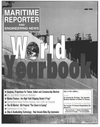
Page 69: of Maritime Reporter Magazine (June 1998)
Read this page in Pdf, Flash or Html5 edition of June 1998 Maritime Reporter Magazine
NAVAL OUTLOOK (Continued, from page 58) exploited by using databuses to link worksta- tions into a net. Each workstation maintains a copy of the overall tactical picture, updates it from its own sensors and draws on whatever information it needs from that database. This means that the tactical picture is continuously being updated and the individual combat sta- tions benefit from much more complete and accurate data.
The great flexibility of fully distributed sys- tems really comes into its own when the tacti- cal situation becomes heated. The flexibility of the system and its workstations can be recon- figured very quickly to match the tactical sce- nario. Resources can be shifted from one com- bat area to another as the situation develops.
If the ship is hit and takes damage, destroyed workstations can be replaced by reconfiguring identical stations elsewhere in the ship — fre- quently this takes as little as inserting the cor- rect authorization card in a slot.
Bringing fully distributed command systems into service took longer and was more difficult than anticipated. The computers and databus- es both revealed quirks that took some time to understand and then eliminate. However, once this had been done, the systems quickly proved of immense value. They also allowed some- thing new but equally important to their com- bat management roles. Ships' functions such as damage control, engine room operation, internal and external communications and even fuel, supplies, personnel records and maintenance logs could be added into the sys- tem. Combat systems evolved into command management systems, allowing ships to be automated with consequent reductions in crew strength. Smaller crews reduced costs and the capital expenditure required to provide habit- ability onboard ship.
As part of a detailed examination of warship cost structures and fits carried out by Forecast
International in Littoral Warfare, it became apparent that the cost of command systems was accounting for between 15 and 45 percent of the total cost of the ship — with the propor- tion increasing in new construction. In one specific case, sea-based flagships dedicated to commanding large-scale naval operations, the cost of C4I facilities rises to almost 80 percent of the cost of the ship.
Naval C4I expenditure need not be concen- trated on the fleet at sea. The provision of ade- quate shore-based command control facilities also adds to the burden of expenditure in this category. The development of modern commu- nication networks has meant that real-time contact can be maintained with fleets on a worldwide basis. It is very tempting to assume that these facilities can substitute for at-sea flagships. Where operations are taking place in proximate littorals — that is littoral waters adjacent to home territory — this is indeed the case. Such operations can be better controlled from land than from sea-based flagships.
However, once force is being projected into more remote littorals, the situation is far from clear. Such communications links can be abused — most notoriously in one Mediter- ranean crisis when U.S. Presidential Aides were attempting use such links to give helm
CUT YOUR COSTS
ABOVE AND BELOW
THE DECK
UNIFLEX RMVA Remote Mechanical
Valve Actuators
Deck Boxes & Remote
Operators
Available in 5, 150 and 250 turns of indication
Flexible Shaft
A single W dia., high-tensile, stainless steel flexible shaft assembly
Output Gear Box
Cyclo gearing, extreme load capacity up to 333 ft. lbs. output torque; complete system ratios of 2:1, 4:1, 6:1. 9:1 and 15:1
Valve Couplings
Standard, quick-disconnect type
NAVSEA design
Less means more. Less weight (up to 40% less than other remote operat- ing gear systems) and less complex installation (single-shaft design) mean more speed, greater payloads and more cost savings (maintenance, repair and opera- tion) for your company. And, our system is remarkably efficient. With as little as 50 ft. lbs. of input you can generate as much as 333 ft. lbs. output torque.
Tested, tried and true. All components are heat resistant, noncorro- sive. Shock- and Vibe-tested. Plus, the Uniflex system is flame tested to API-607 and submergence tested to MIL-STD-810E. Our growing list of satisfied customers speaks for itself—call for references.
Free literature. For more information on Uniflex RMVA, contact our Valve
Control Products team today.
ClUOIT MANUFACTURING
PO Box 773
Binghamton, NY 13902
Telephone (607)772-0404
Fax (607)772-1358
Foam Filled Marine Fenders
Construction complies with United States Navy and Coast Guard Specifications
Core consists of closed-cell, resilient, energy absorbing foam, covered with a protective, seamless polyurethane elastomer skin. Will not mark or scratch vessel hulls ) Easy to install with very little maintenance.
Light Weight and Extremely buoyant with a lower reaction force than either hard rubber or pneumatic fenders (almost 40% higher energy absorption than pneumatic fenders) 1-800-913-0062
Urethane Products Corporation 17007 SOUTH BROADWAY • GARDENA, CA 90248
Tel: 310-532-3662 • Fax:310-532-9884
Complete Line of Foam-Filled Buoys
Circle 272 on Reader Service Card 72 Circle 153 on Reader Service Card Maritime Reporter/Engineering News

 68
68

 70
70
